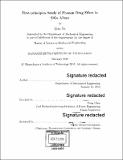| dc.contributor.advisor | Gang Chen. | en_US |
| dc.contributor.author | Xu, Qian,S. M.Massachusetts Institute of Technology. | en_US |
| dc.contributor.other | Massachusetts Institute of Technology. Department of Mechanical Engineering. | en_US |
| dc.date.accessioned | 2019-07-19T19:53:41Z | |
| dc.date.available | 2019-07-19T19:53:41Z | |
| dc.date.copyright | 2019 | en_US |
| dc.date.issued | 2019 | en_US |
| dc.identifier.uri | https://hdl.handle.net/1721.1/121862 | |
| dc.description | Thesis: S.M., Massachusetts Institute of Technology, Department of Mechanical Engineering, 2019 | en_US |
| dc.description | Cataloged from PDF version of thesis. | en_US |
| dc.description | Includes bibliographical references (pages 117-125). | en_US |
| dc.description.abstract | Thermoelectric materials with large figures of merit zT ([mathematical equation], where S, T, [sigma], K are the Seebeck coefficient, absolute temperature, electrical conductivity and thermal conductivity) are promising candidate materials for efficient solid-state devices for electricity generation, cooling and refrigeration. Over the past decades, there has been great progress in enhancing the zT values of thermoelectric materials above 300K, but not much in thermoelectric performance below room temperature due to the relatively small Seebeck coefficient and high thermal conductivity at low temperatures, which limits the efficiency of thermoelectric coolers and refrigerators. First discovered in the 1950s, phonon drag effect describes the phenomenon that the Seebeck coefficients of semiconductors are often enormously augmented at low temperatures. | en_US |
| dc.description.abstract | More recent works have shown that it can play an important role in many materials' thermoelectric performance even at room temperature. One recent study of silicon has pointed out that the major phonons contributing to phonon drag are with longer mean free path and lower frequency than those carrying heat. Meanwhile, alloying has been found to be an effective tool to enhance thermoelectric performance. The point defects in alloys tend to scatter phonons with short mean free path and high frequency which contribute more to thermal conductivity rather than phonon drag. Therefore, combining phonon drag effect with alloying might be a new approach to design better low-temperature thermoelectric materials. However, most of trial-and-error experiments on optimizing the alloys' composition and doping concentration are very time-consuming and theoretical studies with predictive power are much desired as guidelines. | en_US |
| dc.description.abstract | While good progress has been made on first-principles studies on alloys' thermal conductivity, along with a few recent first-principles works on alloying effects on electron mobility, there is little first-principles work done on alloying effect on the Seebeck coefficient, which is another important factor affecting the overall thermoelectric performance, and even less on computing zT within a fully first-principles approach. | en_US |
| dc.description.statementofresponsibility | by Qian Xu. | en_US |
| dc.format.extent | 125 pages | en_US |
| dc.language.iso | eng | en_US |
| dc.publisher | Massachusetts Institute of Technology | en_US |
| dc.rights | MIT theses are protected by copyright. They may be viewed, downloaded, or printed from this source but further reproduction or distribution in any format is prohibited without written permission. | en_US |
| dc.rights.uri | http://dspace.mit.edu/handle/1721.1/7582 | en_US |
| dc.subject | Mechanical Engineering. | en_US |
| dc.title | First-principles study of phonon drag effect in SiGe alloys | en_US |
| dc.type | Thesis | en_US |
| dc.description.degree | S.M. | en_US |
| dc.contributor.department | Massachusetts Institute of Technology. Department of Mechanical Engineering | en_US |
| dc.identifier.oclc | 1102320804 | en_US |
| dc.description.collection | S.M. Massachusetts Institute of Technology, Department of Mechanical Engineering | en_US |
| dspace.imported | 2019-07-19T19:53:36Z | en_US |
| mit.thesis.degree | Master | en_US |
| mit.thesis.department | MechE | en_US |
